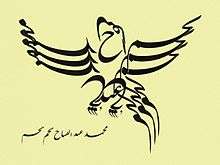Zoomorphism

Zoomorphic text
The word zoomorphism derives from the Greek ζωον (zōon), meaning "animal", and μορφη (morphē), meaning "shape" or "form". It can mean:
- Art that imagines humans as non-human animals[1]
- Art that portrays one species of animal like another species of animal
- Art that creates patterns using animal imagery, or animal style
- Deities depicted in animal form, such as exist in ancient Egyptian religion[2]
- Therianthropy: the ability to shapeshift into animal form[3]
- Attributing animal form or other animal characteristics to anything other than an animal; similar to but broader than anthropomorphism
- The tendency of viewing human behaviour in terms of the behaviour of animals, contrary to anthropomorphism, which views animal or non-animal behaviour in human terms
Examples
Zoomorphic representation in religion
- The appearance of the Holy Spirit like a dove in the New Testament (The Gospel According to Luke 3: 22), "and the Holy Spirit descended on him in bodily form like a dove..."
- Mark the Evangelist as a lion in later Christian iconography.
- The Egyptian gods were often depicted as zoomorphic or as hybrid
- The names of the two most prominent Hebrew Bible female prophets - Deborah and Huldah - were in the Babylonian Talmud interpreted in zoomorphic terms as "wasp" and "weasel."[4]
Zoomorphic language for things, ideas
Humanity portrayed in evolutionary context
Desmond Morris in The Naked Ape and The Human Zoo, Robert Ardrey in African Genesis and Konrad Lorenz in On Aggression all wrote from a sociobiological perspective. They viewed the human species as an animal, subject to the evolutionary law of Survival of the fittest through adaptation to the biophysical environment.[6]
Other
- Fenrisulfr, a wolf in Norse mythology
- Airavata, the king god of elephants in Indian mythology.
- Paw feet bathtub, with feet in the shape of a lion's paws
- The sphinx from the "Oedipus Rex" by Sophocles
- Elephantine Colossus, a hotel
- In The Flintstones and Night at the Museum, the dinosaurs Dino and "Rexy" behave and vocalize like dogs.
- Aslan in The Lion, the Witch and the Wardrobe is a lion that is the king of Narnia
- Robotic pets, like AIBO, modeled on dogs or other animals
- In 2010 city planners from Southern Sudan, which would become independent a year later, unveiled plans for the city center of its capital, Juba, to be built in the shape of a rhinoceros. The city of Wau was to be transformed in the shape of a giraffe.[7]
See also
References
| Wikimedia Commons has media related to Animal-shaped objects. |
- ↑ Hope B. Werness, The Continuum Encyclopedia of Animal Symbolism in Art, Continuum International Publishing Group, 2004, px. ISBN 0-8264-1525-3
- ↑ Simson R Najovits, Egypt, Trunk of the Tree: A Modern Survey of an Ancient Land, Algora Publishing, 2004, p 279. ISBN 0-87586-201-2
- ↑ Gerina Dunwich, Wicca A to Z: A Modern Witch's Encyclopedia, Kensington Pub Corp, 1998, p 155. ISBN 0-8065-1930-4
- ↑ Blaženka Scheuer; Animal Names for Hebrew Bible Female Prophets, Literature and Theology, Volume 31, Issue 4, 1 December 2017, Pages 455–471, https://doi.org/10.1093/litthe/frx032
- ↑ Synthesis: bulletin du Comité national de littérature comparée / Comitetul Național pentru Literatură Comparată, Institutul de Istorie și Teorie Literară "G. Călinescu." - 2002 "Sin is personified as (an animal?) which "crouches" at the door of Cain (Gen 4:7). As Gerhard von Rad (Genesis, 105) remarks, 'The comparison of sin with a beast of prey lying before the door is strange, as is the purely decorative use "
- ↑ William Ickes, Compatible and Incompatible Relationships, Springer Verlag, 1985, p.26
- ↑ Howden, Daniel (2010-08-19). "Turn left at the horn: 'Rhino City' revealed - Daniel Howden, ''9 August 2010''. The Independent". Independent.co.uk. Retrieved 2014-03-14.
This article is issued from
Wikipedia.
The text is licensed under Creative Commons - Attribution - Sharealike.
Additional terms may apply for the media files.